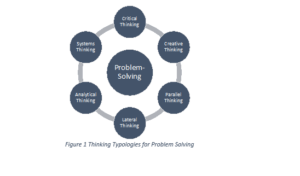“A problem is a chance for you to do your best.” – Duke Ellington
Isn’t life all about problem-solving? Effective leaders are those who can find answers to difficult questions in a constantly changing environment – an ability that stems from developing problem-solving proficiencies across the board. And, yes, even though most business leaders talk about solving problems, they are frequently in reactive states which means that these problems are never truly solved; and the symptomatic form of it resurfaces over time.
We should think about problem-solving in terms of three ‘Levels of Fix’:
- Level 1: Fix the Product.
- Level 2: Fix the Process.
- Level 3: Fix the System.
In most cases, Level One is reactive as it arises during the course of a typical workday, and managers must respond accordingly. Sometimes or very often, we never progress beyond level one or stay there for too long, causing the same problem to reoccur. The journey from Levels two to three will require a more proactive approach. That will be the focus of the first of many Problem-Solving series I will be sharing.
I thought to start off on this lighter note. Well, lighter note because it’s been a part of my own learning journey – those soft skills that I kind of overlooked, or didn’t state succinctly enough as I helped thousands of professionals to develop problem-solving capabilities over the past 15 years. I had to step back and rethink how I deliver this competency. This is how I captured my epiphany:
“Without the proper thinking frames or thinking typologies, problem-solving tools and techniques are ineffective, even within the best frameworks.”
Problem-solving is as much about applying problem-solving tools, whether they are contained within the Seven Quality Control Toolbox (a.k.a. Ishikawa’s 7QC) or the internationally acclaimed Six Sigma DMAIC Toolbox [I will be doing full-blown features on these methodologies in later issues]; as it is about developing the right frames of thinking, both individually and within problem-solving teams. I’ve coined the term ‘Thinking Typologies’ to describe these mental states.
The two problem-solving hemispheres
Let’s think about your problem-solving continuum to exist within two seamless hemispheres: the problem space and the solution space. The problem space is that part of the process where problem-solving teams work on unravelling the problem. It is the deep-dive into the transfer equation: y=f(x); where y is the problem [the outcome, the output, what the symptoms are]; and x are the potential causes [a lot more of this later]. The solution space refers to the actions we take to generate, evaluate, select, test and implement the best solutions to the problem we have previously well-understood. The unfortunate part is that most business leaders are more likely to jump into the solution space without even giving the problem a cursory glance. Problem solvers and problem-solving teams should be well-versed in both areas; otherwise, what’s the point of being able to root-cause analyse a problem if you can’t implement good solutions? The reverse would also be true.
The mental typologies for problem solvers
When looking for great solutions to our problems, there are several roadblocks and potential issues that we must avoid at all costs. For instance:
- We don’t want problems solved piecemeal with the risk of resurfacing later.
- We don’t want the solutions to our current problems to become future problems or to be passed on to other parts of the business.
- We don’t want half-baked solutions that only act as band-aid measures.
These are the real reasons why problem-solving teams ought to be equipped with the necessary thinking models.
Henry Ford puts it this way: “Thinking is hard work, which is why so few people do it’”; and perhaps that’s the same reason why “Five percent of the people think; ten percent of the people think they think; and the other eighty-five percent would rather die than think.” (Edison).
The litmus test of an effective problem-solving team and a problem-solving leader is how they navigate the complex problem-solving terrain, applying tried and tested methodologies while determining where in the process they need to plug in the different thinking typologies, mental models to deploy, and frames of mind the team members should be in.
Now, whether in the problem or solution space, there should be some mental states that individuals and teams should be in throughout the lifecycle from problem definition, root cause analysis, solution generation, and post-delivery operationalisation. Some of these mental states or thinking typologies are more prominent in one space than another while others cut across phases. Let me provide an overview of six thinking typologies (Figure 1) that our problem-solving teams should have.

A summary of our six mental models
In subsequent issues, we will be conducting deep-dives into each of these mental models, their contextual and practical meanings, and how we can develop these as organisation-wide competencies – particularly with a focus toward problem-solving.
- Analytical thinkingis the act of breaking down complex pieces of information into smaller and more understandable component or principles. It involves systematically dismantling data to decipher facts which can be used to build on information or provide evidence-based conclusion.
- Critical thinkingmeans carefully weighing information or views, and interpreting them to make sound independent judgments. It is also cyclical, meaning one can go round and round considering facts to form an opinion, cultivate a conviction, or just determine whether something is valid or makes sense.
- Creative thinkingis the mental process of bringing something new into existence through imagination. It involves the input of facts and sensory stimuli, as well as interpolation and critical reflection to imagine something that does not exist.
- Lateral thinking is defined as solving problems through an indirect and creative approach using reasoning that is not immediately obvious, and involving ideas that may not be obtainable by using only traditional step-by-step Logic.
- With Parallel thinking, both sides (or all parties are thinking in parallel in the same direction). There is co-operative and coordinated thinking. The direction itself can be changed in order to give a full scan of the situation. But at every moment each thinker is thinking in parallel with all the other thinkers.
- Systems thinking and practice help us to view reality holistically, and ensure that our solutions do not become new problems but genuine breakthroughs.
Connection with future-proof skills
As an educator and a continuous professional development provider, I have been constantly on the lookout (from sources like the Harvard Business Review, Forbes Magazine, etc.) for skills and competencies required by top recruiters and employers globally. Some skills have remained consistently on the top list of requirements over the years; and there are yet those that have been much more accentuated coming into 2022, and also COVID global business era. The list below comes from the WEF’s 2022 Skills Outlook:
- Analytical thinking and innovation
- Active learning and learning strategies
- Creativity, originality and initiative
- Technology design and programming
- Critical thinking and analysis
- Complex problem-solving
- Leadership and social influence
- Emotional intelligence
- Reasoning, problem-solving and ideation
- Systems analysis and evaluation
What I find most gratifying is the sheer number of competencies (bold) on this list that correspond to our original six mental models, which I have outlined. So, as we prepare for our dive into the deep end, let me state this: these are truly future-proof competencies required for career advancement and organisational development, and I look forward to assisting us in developing these competencies in our upcoming issues.










